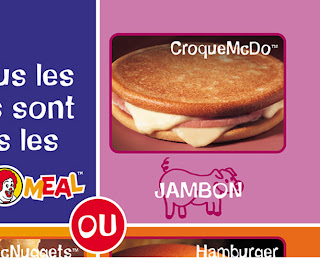In exploring the menu as a genre, I was curious to see how much McDonald’s–a familiar, all-American fast-food chain that would presumably wish to bank on consumers’ nostalgia and need for “comfort” food–has been “continentalized,” or made to sound to more, well, chic. When I went to the McDonald’s website to explore, I was greeted with a picture of softly-lit oatmeal, apple slices, and yogurt with the subtitle “Wholesome” in cursive letters. Continentalized? Absolutely. A look at the menu, however, shows McDonald’s menu to be more in transition than the website suggested: it contains many familiar items with simple but accurate names (“Double Quarter Pounder with Cheese”) as well as branded items with the prefix “Mc-” (“McDouble, “McChicken,” etc.). Yet the menu also contains items with more complex names, some of which incorporated foreign flavors, such as the “Angus Chipotle BBQ Snack Wrap,” or used descriptors common to menus across America (e.g. “Premium Crispy Chicken Classic Sandwich”). Speaking of chicken, McDonald’s makes a distinction between “grilled” chicken and “crispy” chicken, which is battered and fried (an appetizing adjective that comes across as more neutral than, say, “fried,” to people watching their cholesterol intake). The food names also suggest when the foods are intended to be eaten: small chicken nuggets are called “Chicken McBites,” and small wraps are called “Snack Wraps,” suggesting that these foods are consumed in between meals.
 |
| http://i2.cdn.turner.com/money/galleries/2008/ fortune/0805/gallery.royale.fortune/images/croque.jpg |
It's interesting when you note how McDonalds has chosen to "continentalize" their menu in an attempt to make their food more appealing and wholesome-sounding. In Hong Kong, there are also attempts made to tailor menus to local tastes - including changes made for the sake of attracting a different culture of consumers.
ReplyDeleteWhile the original American menu uses words like "angus" that would mean nothing to a Hong Konger, the McDonalds' back home have food items including:
- Red bean/taro pie
- Adzuki bean ice-cream
- Shogun burger (a teriyaki pork patty with lettuce, served in a sesame seed bun)
- Macaroni in soup (a traditional Hong Kong breakfast)
- Rice Fantastic (a burger-like entree with rice patties in place of buns)
Obviously, McDonalds has done a good job of targeting local tastes and adapting "exotic" flavors into their menus just as French McDonalds' have. Even more interesting was the exclusion (until recently) of the Quarter Pounder, since we use the metric system. I find that internationally, McDonalds does a very skillful job of striking the balance between maintaining their trademark American identity, while appealing to local habits and preferences, as is revealed by their menus. It makes you wonder whether other fast-food chains have adopted similar strategies when opening branches overseas...